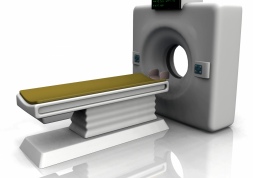
An X-ray image of the knee

A new system that enables medics to image difficult areas of the body is being developed by researchers at Imperial College London.
A new system that enables medics to image difficult areas of the body, which could potentially improve the way procedures such as knee replacement surgery are carried out, is being developed by researchers at Imperial College London.
The team are making a new type of compact, low cost Magnetic Resonance Imaging (MRI) system for hospitals that could improve the way that joints including knees and elbows are scanned. The new system could help doctors to make more informed decisions about surgery, which could improve outcomes and recovery times for patients.
The team say the finished MRI instrument will be the size of a coffee table, fitting neatly around the knee. Standard hospital MRI machines are currently the size of a small car and cost around £900,000 – a significant portion of which pays for installation. The new machines will be cheaper to manufacture, costing only an estimated £200,000. The features of the new MRI device including small size and low power requirements mean installation costs could be minimal, say the researchers.
Each year the NHS carries out more than 70,000 knee replacement surgeries in the UK. However, it is difficult for doctors to image parts of the body that have high collagen content – such as ligaments and tendons in knees and elbows – using standard MRI technology. As ligaments inside the knee cannot be imaged in enough detail to be sure of how robust they are, doctors often opt for a full replacement to ensure the end result is a working knee. This can increase healthcare costs and impact on patient recovery times.

It is difficult to image parts of the body with a high collagen content using standard MRI devices
Dr Mihailo Ristic, from the Department of Mechanical Engineering, will be developing the new system. He says: “Standard MRI machines use a cylindrical magnet that tightly encloses the patient. This prevents doctors from positioning body parts at different angles when patients are in the machine.
If doctors were able to achieve a specific angle between the body parts and the magnetic field then the MRI signal strength can be increased by up to 50 times when imaging hard to see ligaments and tendons. This is known as the ‘magic angle’ effect, and occurs only when the magnet and tissue structures are positioned at exactly 54.7 degrees to one another. Under these conditions the hydrogen atoms in the body’s tissues provide a significantly enhanced MRI signal. That means the ligaments and tendons – which would otherwise appear black in the scan – can be seen clearly.
Some modern MRI machines use horseshoe shaped magnets instead of the cylindrical ones, and the former offer a much less claustrophobic experience for the patient. Even these aren’t designed to make use of the ‘magic angle’ effect, however. Funding from the National Institute for Health Research (NIHR) will now allow Dr. Ristic to design a completely new magnet that will be quite unlike the more conventional horseshoe shaped or cylindrical designs. The magnet will be moveable and the field it produces will be oriented at various angles to the patient’s body.
The first year of the project, which runs for three years, will be spent perfecting the magnet design, using software developed by the Ristic research group. By the end of the project, the Imperial scientists aim to collaborate with industrial partners to produce a commercial product.
The system will be designed specifically for knees, but this approach could also be used to image a wide variety of body parts. Dr Ristic concludes: “The potential for this technology is tremendous. We believe that every hospital would want to have one.”
Article text (excluding photos or graphics) available under an Attribution-NonCommercial-ShareAlike Creative Commons license.
Photos and graphics subject to third party copyright used with permission or © Imperial College London.
Reporters
Joshua Howgego
Department of Humanities

Contact details
Email: press.office@imperial.ac.uk
Show all stories by this author
Colin Smith
Communications and Public Affairs

Contact details
Email: press.office@imperial.ac.uk
Show all stories by this author



